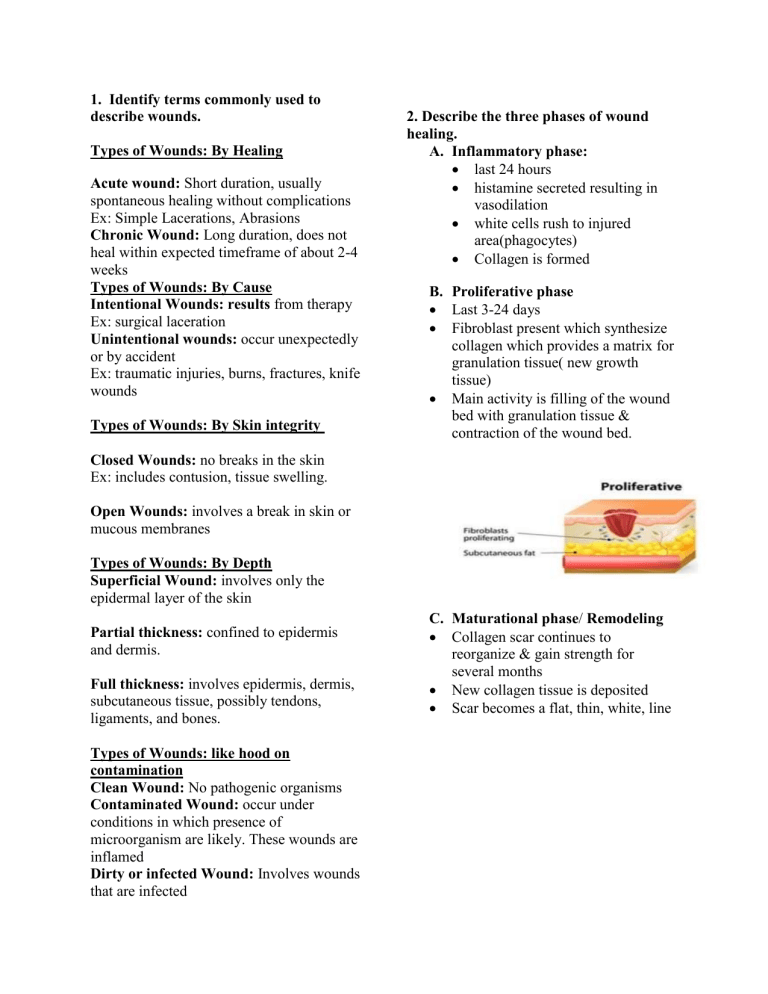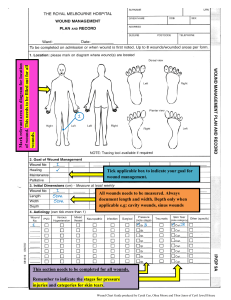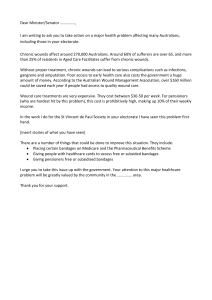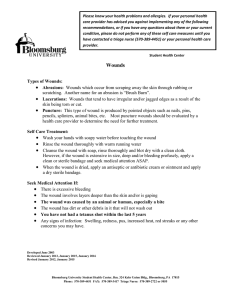
1. Identify terms commonly used to describe wounds. Types of Wounds: By Healing Acute wound: Short duration, usually spontaneous healing without complications Ex: Simple Lacerations, Abrasions Chronic Wound: Long duration, does not heal within expected timeframe of about 2-4 weeks Types of Wounds: By Cause Intentional Wounds: results from therapy Ex: surgical laceration Unintentional wounds: occur unexpectedly or by accident Ex: traumatic injuries, burns, fractures, knife wounds Types of Wounds: By Skin integrity 2. Describe the three phases of wound healing. A. Inflammatory phase: last 24 hours histamine secreted resulting in vasodilation white cells rush to injured area(phagocytes) Collagen is formed B. Proliferative phase Last 3-24 days Fibroblast present which synthesize collagen which provides a matrix for granulation tissue( new growth tissue) Main activity is filling of the wound bed with granulation tissue & contraction of the wound bed. Closed Wounds: no breaks in the skin Ex: includes contusion, tissue swelling. Open Wounds: involves a break in skin or mucous membranes Types of Wounds: By Depth Superficial Wound: involves only the epidermal layer of the skin Partial thickness: confined to epidermis and dermis. Full thickness: involves epidermis, dermis, subcutaneous tissue, possibly tendons, ligaments, and bones. Types of Wounds: like hood on contamination Clean Wound: No pathogenic organisms Contaminated Wound: occur under conditions in which presence of microorganism are likely. These wounds are inflamed Dirty or infected Wound: Involves wounds that are infected C. Maturational phase/ Remodeling Collagen scar continues to reorganize & gain strength for several months New collagen tissue is deposited Scar becomes a flat, thin, white, line Tertiary intention or delayed primary closure: Occurs when two surfaces of granulation tissue are brought together. Initially the wounds are left to heal by secondary intention and later the wound edges are closed (Treas, 2nd ed., 2018). . 3. Differentiate primary, secondary, and tertiary wound healing. Types of healing: Primary Intention: Occurs when there is little, or no tissue loss and skin edges approximated (close together) E.G., Surgical incision, wound stapled or sutured Secondary Intention: Involves loss of tissue that prevents would edges from approximating or should not be closed because of infection. Wound heals from inner layer to the surface E.G., Pressure ulcers, surgical wounds with tissue loss 4. Identify major types of wounds and exudate. (drainage) A. Serous drainage: Straw colored. watery consistency. Contains very little cellular matter. 5. Identify major types of wounds and exudate.(drainage) Continued B. Sanguineous Drainage: Bloody drainage D. Purulent drainage Thick drainage, seen in infected wound Trivia: True or false 1. Purulent drainage is always indicative of an infection. Answer: C. Serosanguineous Drainage Combination of bloody and serous drainage 2. Which of the following is least likely to decrease the risk of infection? a. Hand washing prior to changing a wound dressing. b. Cleaning the surface of the table prior to placing dressing supplies on it. c. Storing dressing supplies in a dry, cool and clean environment. d. Elevating the affected extremity on a pillow. Answer: 6. tissue, muscle atrophy and predisposes to pressure injury Describe factors that affect wound healing. Developmental considerations o Infants and children - Thinner skin is more permeable and therefore more susceptible to infection. Electrolytes and vitamins ascorbic acid, zinc and copper are needed for the maintenance and formation of collagen. Hydration o Adolescents and adults - - Increased sebaceous and sweat gland activity, prone to acne and perspiration High estrogen in females leads to striae and darkening/ pigmentation of the skin Affects skin turgor which in turn affects skin integrity. o Older adults - - Diminished skin elasticity increases the risk of skin breakdown Drier skin, loss of lean body mass, thinning of subcutaneous tissue Nutrition o Protein - Needed for wound healing, maintain skin integrity and preserve intravascular volume Cholesterol Low levels predispose patients to skin breakdown and inhibits wound healing Calories Inadequate caloric intake leads to loss of weight and subcutaneous Life-style Medication (anything that causes itching, rashes, photosensitivity, alopecia, or pigmentation changes) Infections Disease process




